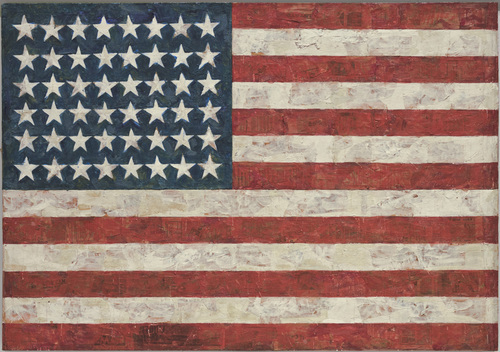 “One night I dreamed that I painted a large American flag,” Johns has said of this work, “and the next morning I got up and I went out and bought the materials to begin it.” Those materials included three canvases that he mounted on plywood, strips of newspaper, and encaustic paint—a mixture of pigment and molten wax that has formed a surface of lumps and smears. The newspaper scraps visible beneath the stripes and forty-eight stars lend this icon historical specificity. The American flag is something “the mind already knows,” Johns has said, but its execution complicates the representation and invites close inspection. A critic of the time encapsulated this painting’s ambivalence, asking, “Is this a flag or a painting?” -- (from the Museum of Modern Art's Gallery Label text, 2011)
“One night I dreamed that I painted a large American flag,” Johns has said of this work, “and the next morning I got up and I went out and bought the materials to begin it.” Those materials included three canvases that he mounted on plywood, strips of newspaper, and encaustic paint—a mixture of pigment and molten wax that has formed a surface of lumps and smears. The newspaper scraps visible beneath the stripes and forty-eight stars lend this icon historical specificity. The American flag is something “the mind already knows,” Johns has said, but its execution complicates the representation and invites close inspection. A critic of the time encapsulated this painting’s ambivalence, asking, “Is this a flag or a painting?” -- (from the Museum of Modern Art's Gallery Label text, 2011)
When Johns made Flag, the dominant American art was Abstract Expressionism, which enthroned the bold, spontaneous use of gesture and color to evoke emotional response. Johns, though, had begun to paint common, instantly recognizable symbols—flags, targets, numbers, letters. Breaking with the idea of the canvas as a field for abstract personal expression, he painted "things the mind already knows." Using the flag, Johns said, "took care of a great deal for me because I didn't have to design it." That gave him "room to work on other levels"—to focus his attention on the making of the painting.
The color, for example, is applied not to canvas but to strips of newspaper—a material almost too ordinary to notice. Upon closer inspection, though, those scraps of newsprint are as hard to ignore as they are to read. Also, instead of working with oil paint, Johns chose encaustic, a mixture of pigment and molten wax that has left a surface of lumps and smears; so that even though one recognizes the image in a second, close up it becomes textured and elaborate. It is at once impersonal, or public, and personal; abstract and representational; easily grasped and demanding of close attention. -- (From The Museum of Modern Art, MoMA Highlights, New York: The Museum of Modern Art, revised 2004, originally published 1999, p. 232.

